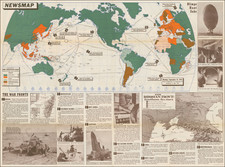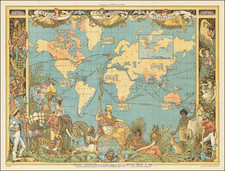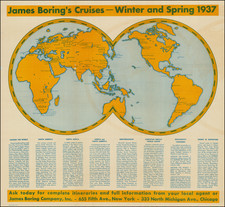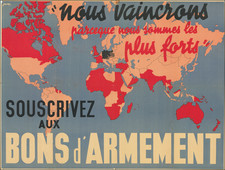The 1880 Hakluyt Society edition of the Wright Molyneux map, created by the Typographic Etching Company.
The Wright-Molyneux Map, a notable cartographic feat of the Elizabethan era, holds the distinction of being the first English map based on Gerard Mercator's revolutionary projection.
The present example, a rare reproduction by the Hakluyt Society, is printed using a proprietary reproductive process pioneered by the Typographic Etching Company of London. Named for Richard Hakluyt (1552–1616), a collector and editor of narratives of voyages and travels and other documents relating to English interests overseas, The Hakluyt Society is a text publication society, founded in 1846 and based in London, England, which publishes scholarly editions of primary records of historic voyages, travels and other geographical material.
Among its other important cartographic first, the Wright-Molyneux Map names Lake Ontario for the first time and is among the earliest maps to use the term "Virginia."
This map was issued concurrently with the 1599 edition of Richard Hakluyt's 'Principall Navigations,' a comprehensive collection of English maritime voyages that epitomizes the Elizabethan period's literary and nautical prowess.
Wright-Molyneux Map: A Cartographic Breakthrough
Gerard Mercator, a luminary in cartography, introduced projection method in the 16th century which transformed mapmaking. However, his lack of practical usage guidelines left a gap filled by Edward Wright, a Cambridge mathematics professor. Wright's adaptation of Mercator's projection, detailed in his book, The Correction of Certain Errors in Navigation (1599) and its refined version in 1610, provided navigators with essential mathematical tables and instructions. This advancement played a vital role in establishing British naval dominance and remains a cornerstone of modern navigation.
The map, first published in 1599, was based on a globe by English globe maker Emeric Molyneux from 1592 and was the first to incorporate Wright's modifications. Its significance even reached cultural spheres, as evidenced by its mention in Shakespeare's "Twelfth Night."
Wright's map is distinguished by its minimalistic detail, deliberately leaving uncharted areas blank, particularly along coastlines. For instance, the region above California's Cape Mendocino is purposefully empty. This approach contrasts sharply with contemporary maps often filled with speculative content.
Geographical Notations and Innovations
The map presents a broader Pacific Ocean than its contemporaries and labels upper California as 'Nova Albion,' a name given by Sir Francis Drake, diverging from the common 'Anian' designation. Intriguingly, it includes an early depiction of 'Lake Tadouac,' potentially referencing the Hudson Bay or Great Lakes, predating their European discovery. This map also marks one of the earliest uses of the name "Virginia."
The second state of the map from 1599 adds a cartouche describing Drake's American discoveries. Decorative elements include Elizabeth I's coat of arms, a cartouche about Spanish explorer Francis Gaulle’s Pacific discoveries in 1584, and a general description of the chart.
The Principall Navigations: A Literary and Nautical Treasure
'The Principall Navigations' is an expansive collection of 243 travel narratives, making it an essential resource for understanding early New World exploration. This second edition of 1599, vastly different from the 1589 original, includes significant additions like the travels of Newbery and Fitch, Lancaster's voyage, and Raleigh's adventures. Hakluyt's meticulous compilation captures the spirit of the Tudor age and remains a crucial historical and geographical sourcebook.
Hakluyt, who never ventured far from England, relied on connections with prominent explorers and cartographers, such as Drake, Raleigh, and Mercator, to compile his work. The publication, a major Tudor state project, aimed to champion English exploration, akin to Holinshed's Chronicles role in national history. Volume three focuses on the Americas and South Seas, featuring accounts from various explorers, underscoring Hakluyt's advocacy for British overseas expansion, both for economic and religious reasons.
In conclusion, the Wright-Molyneux Map, in conjunction with 'The Principall Navigations,' represents a pivotal moment in the history of cartography and exploration literature. It symbolizes the ambition and ingenuity of the Elizabethan era, offering a window into the world as understood by the English during a time of global discovery and expansion.
Includes the following text entries in the cartouche and two text boxes:
It appeareth by the discoverie of Francis Gaulle, a Spaniard, in the yeare 1584, that the sea betwene the west part of America and the east of Asia (which hath bene ordinarily set out as a straight and named in most maps as the streight of Anian) is above 1200 leagues wide at the latitude of 38 degr. And that the distance betwene cape Mendocino and cape California which many maps and seacharts make to be 1200 or 1300 leagues is scarce so much as 600.
[and]
Thou hast here gentle reader a true hydrographical description of so much of the world as hath beene hetherto discouered, and is comme to our knowledge. which we haue in such sort performed, yt all places herein set downe, haue the same positions and distances that they haue in the globe, being therin placed in same longitudes and latitudes which they haue in this chart, which by the ordinarie sea-chart can in no wise be performed. The way to find the position, or course from any place to other herein described, differeth nothing from that which is vsed in the ordinarie sea chart. But to finde the distance; if both places haue the same latitude, see how many degrees of the meridian taken at that latitude are contayned betweene the two places, for so many score leagues is the distance. If they differ in latitude, see howe many degrees of the meridian taken about the midst of that difference are conteyned betweene; them and so many score leagues is the distaunce.
[and]
I haue contented my self with inserting into the worke one of the best generall mappes of the world onely, untill the comming out of a very large and most exact terrestrial Globe, collected and reformed according to the newest, secretest, and latest discoveries, both Spanish, Portugall, and English, composed by M. Emmerie Mollineux of Lambeth, a rare Gentleman in his profession, being therein for divers yeeres, greatly supported by the purse and liberalitie of the worshipfull marchant M. William Sanderson.
The Typographic Etching Company was founded by British etcher and artist Alfred Dawson, with his brother Charles Dawson in London around 1872. It later became the Typographic Etching and Engraving Company.
Rarity
This is the first time we have ever seen this 1880 edition for sale.
OCLC locates 2 copies: Yale and Johns Hopkins University.










![[Early Fascimile of the Disputed Christopher Columbus Portolan Chart]](https://storage.googleapis.com/raremaps/img/small/66588.jpg)



![[Pan American Menu Map] (World)](https://storage.googleapis.com/raremaps/img/small/104021.jpg)